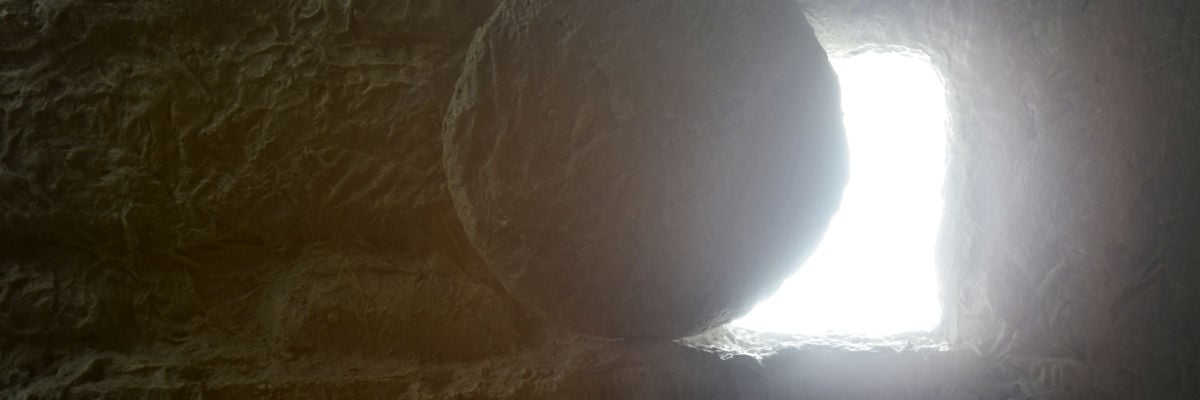
Did God die? Was God buried?
The short answer to both of these questions is yes. But before giving reasons for this belief, we must remember that the Incarnation is one of the greatest among the many mysteries essential to our Catholic faith. As St. Paul so eloquently declared,
Great indeed, we confess, is the mystery of our religion: He [some ancient manuscripts read “God”] was manifested in the flesh, vindicated in the Spirit, seen by angels, preached among the nations, believed on in the world, taken up in glory (1 Tim. 3:16).
It is precisely because of this “great mystery” that we celebrate each Christmas—“God was manifest in the flesh”—that we have to answer yes, God died, God was buried, and more. In fact, we could add to the queue manifold related questions. Was God nurtured, fed? Did he learn to walk and talk? Did he experience pain and suffering, both physical and spiritual, and more? And, indeed, the answer to each of these questions is one resounding yes!
Now, it is one thing to give the answer to these questions at the back of the book, but it is another entirely to give what St. Peter described as “a defense to anyone who calls you to account” for your faith in the matter (1 Pet. 3:15). In fact, over the years, I have found that these questions come not only from skeptics on the outside looking in, but from Catholics in the pew as well. Christians are quite often initially shocked when they hear “God died,” “God was born,” or “God was buried.”
The best way, I have found, to help folks to understand the answers—or the answer—to each of these questions is to get to the core of what the Church calls the hypostatic union. That term describes in a word the great mystery of the Incarnation: the Second Person of the Blessed Trinity assumed a fully human nature so that the one Person of Jesus Christ now possesses two natures within the one, divine Person. Hypostatic union comes from the Greek word hypostasis, which the Church came to use as a synonym for the Latin word persona, or “person.” Originally, hypostasis had a wider semantic range in ancient Greek, but the Church came to use it, and now uses it perennially, with a more narrow focus as “person.”
Thus, hypostatic union refers to the joining of the two natures of Christ—one divine, one human—within the hypostasis, or “person,” of Christ. This “joining” or “union” is not to be understood as a mingling of natures. Each nature remains fully distinct. But they are not to be understood as substantially separated, either. The hypostatic union is a substantial union, meaning we are talking about “one thing” here. One person. One subject. But that one subject, Jesus Christ, a divine person, possesses two natures, one divine and one human.
It is because the one, divine Person of Jesus Christ possesses these two natures that it becomes entirely correct to say he, the divine Person of Christ, suffered, died, etc. Because of the hypostatic union, everything experienced in the two natures of Christ must be said to be experienced by the one, divine Person. He, the divine Person of Christ, is the subject of everything experienced through his two natures.
The Catechism of the Council of Trent, under the section on the Creed, Article Four, perhaps says it as well as it can be said. Here, the Catechism is answering the question of whether or not it is proper to say, “God was buried.”
This question is particularly interesting because when we normal humans die—and by “normal,” I mean all of us that are not God!—our “person” ceases to exist, strictly speaking. Why? Because, by definition, a human person is constituted as a body-soul composite. Without both, you do not have a person. This is why we refer to the “souls” in Purgatory, for example, and not the “persons” in purgatory. They are “souls,” and not persons, properly speaking, because they do not possess bodies. This is also why Scripture refers to the souls in heaven as “the spirits of just men made perfect” (see Heb. 12:22-24), or as “the souls of the martyrs” (Rev. 6:9). Until the resurrection of the body, the “spirits” and “souls” are not fully “persons.”
Well, in the case of Jesus Christ, he is not a human person. He is a divine person. Thus, it is impossible for his “person” to cease to be. Thus, you will notice the Catechism referring to Christ’s body still being joined to the divine Person, even in death:
It is not, however, our belief that the body of Christ alone was interred. The above words [referring to the Creed stating that Christ “was buried”] propose, as the principal object of our belief, that God was buried; as according to the rule of Catholic faith we also say with the strictest truth that God died, and that God was born of a virgin. For as the Divinity was never separated from his body which was laid in the sepulcher, we truly confess that God was buried.
And because “the Divinity was never separated from his body,” or from his human nature, we can also say God was nurtured and fed, God learned to walk and talk, God experienced pain and suffering, and more.



